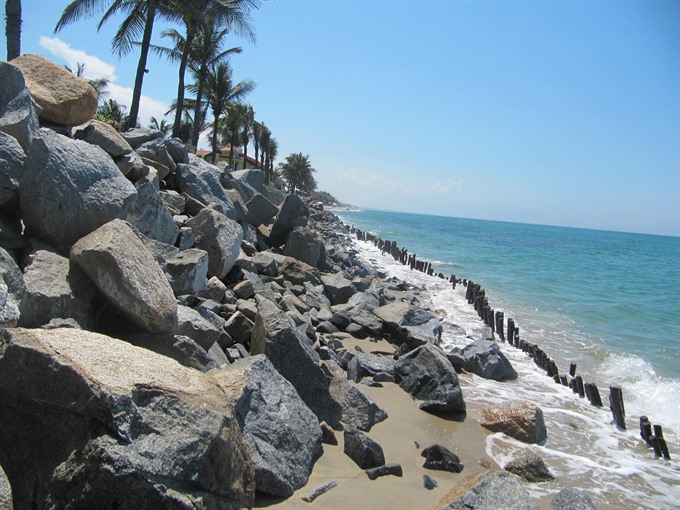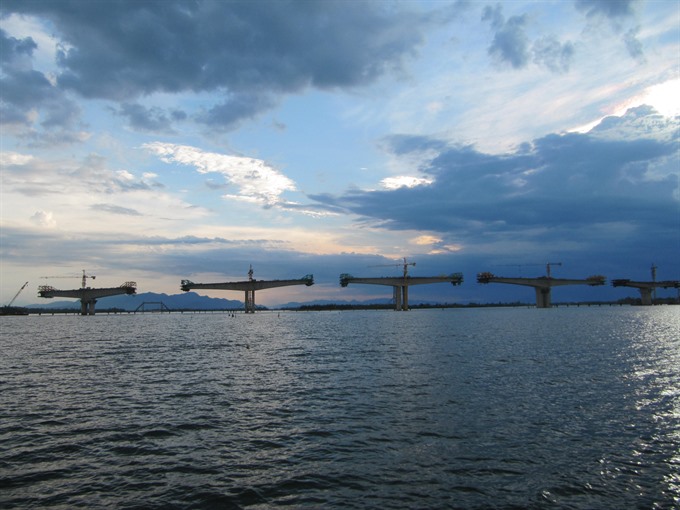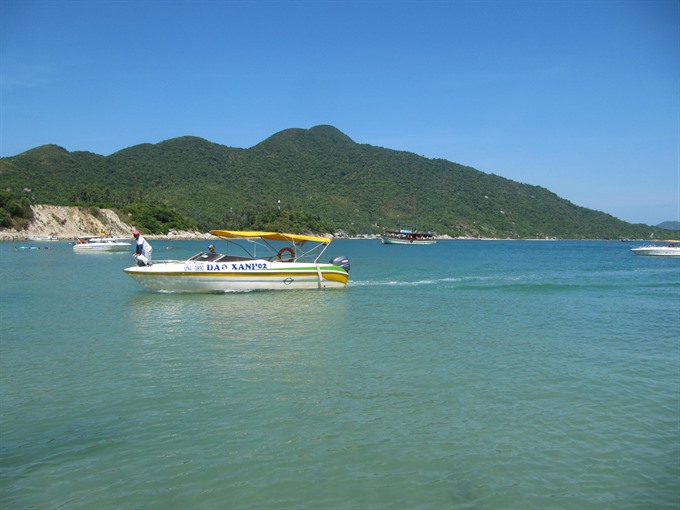 Society
Society

Too many hydropower projects, poor environmental impact assessments of their dams, and overexploitation of sand are haunting Hội An City and surrounding areas.
 |
| Rocks on the Cửa Đại beach have been used to protect a local resort. |
HỘI AN — Too many hydropower projects, poor environmental impact assessments of their dams, and overexploitation of sand are haunting Hội An City and surrounding areas.
The above-mentioned factors, combined with poor management by local officials, have caused and worsened serious land erosion in the Vu Gia-Thu Bồn River Basin, experts, researchers and officials said a meeting on Thursday.
The meeting was attended by staff of the International Union for Conservation of Nature (IUCN), Man and Biosphere, UNESCO, and Chàm Island Managing board.
They stressed the importance of natural sandbanks and ensuring sustainable development of Hội An City.
The 32km Vu Gia-Thu Bồn River basin has seen serious erosion due to the change of flows from the riverhead, washing away large tracts of land on both banks for a 500m stretch.
The latest report on the situation shows annual erosion has been swallowing between 2m-10m of land in four communes of Hội An City, while the river itself has moved 140m southeast from its position 40 years ago.
Chu Mạnh Trinh, a team leader of the Chàm Islands Marine Protected Area, said businesses had been exploiting a huge amount of sand in the river basin, and big hotels and resorts were being constructed on the sandbanks.
“We carried out field trips along the river and found numerous boats docked to mine sand. They are like “sharks” swallowing lucrative ‘meat’. Hundreds of tonnes of sand are dredged for construction every day,” Trinh said.
“We even discovered a big pipe system installed under the sandbanks to dig for sand. Some sandbanks have completely collapsed, leaving a channel in the middle,” he said.
Trinh said a huge resort, which is under construction on the Hến sandbank in the river basin, could destroy the river basin area.
Bùi Thị Thu Hiền of the IUCN said rapid development of hydropower plants on the river negatively impacted the sandbanks and the livelihood of millions in the basin.
“Many hydropower plants in Quảng Nam Province were built without any consultation with or feedback from neighbouring provinces and downstream areas, while investors and management agencies neglected to draw up detailed flood control plans,” Hiền said.
She said experts with the Japanese International Co-operation Agency (JICA) had revealed that environment impact assessments were not carefully done before building hydropower plants and other structures.
For instance, construction of the Đắk Mi 4 hydro-power plant in Quảng Nam Province caused a clean water deficit during every dry season in Đà Nẵng City.
She said a Quảng Nam-Đà Nẵng joint committee on integrated management of the river basin was established, but separate operations by Quảng Nam and Đà Nẵng resulted in poor water management and worsening erosion.
At Thursday’s meeting, Đà Nẵng and Quảng Nam administrations okayed a joint-management agreement on the river basin and coastline.
According to Trần Thị Hồng Thúy, director of Chàm Island Maritime Protection Centre, the river basin belongs to the Chàm Island-Hội An World Biosphere Reserve of over 33,000ha.
She said human activities and poor control at the Vu Gia-Thu Bồn riverhead had badly affected the ecology of the area recognised as a World Biosphere Reserve in 2009.
“A terraced hydropower plant system on the river, illegal exploitation of sand, ore mining and overuse of chemicals by industrial parks, factories and households have polluted the river, threatening the marine ecology system,” Thúy said.
“Increasing construction of resorts and hotels on the river banks and sandbanks – included in the buffer and core zones of the World Biosphere Reserve are – will lead to extinction of marine creatures, coral reefs and seaweed around Chàm Island,” she warned.
Nguyễn Sự, former Party secretary of Hội An City, said the destruction of sandbanks in the river threatened the sustainable development of Hội An – a UNESCO-recognised World Heritage site, as it targets to become the nation’s first eco-city.
Sự also protested the “reinforcement” of sandbanks and riverbanks by concrete buildings. He warned that without “tender management” of the river basin, Hội An City and the Chàm Island World Biosphere Reserve will be badly damaged.
According to Nguyễn Chu Hồi, a researcher of environment and coastal resources at the National University, said an integrated watershed and coastal management approach ‘from ridge to reef’ was needed in the Vu Gia-Thu Bồn river basin.
He said the development of irrigation projects and hydropower plants had limited water flow from the river basin, causing serious erosion of beaches in Hội An City.
He said a vast stretch of the Cửa Đại Beach near Hội An had gradually disappeared over the last 10 years, and erosion on the river banks of Thu Bồn was threatening the very existence of the heritage city. — VNS
 |
| A bridge over the Thu Bồn River. A profusion of constructions in the Vu Gia-Thu Bồn River has seriously eroded its banks and altered its flow. |
 |
| Chàm Island off the coast of Hội An City is part of a World Biosphere site. Poor management of the Vu Gia-Thu Bồn River has damaged the site and poses a serious threat to Hội An City. — VNS Photos Công Thành |




